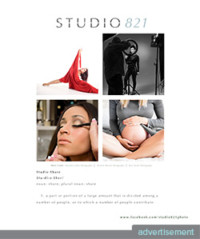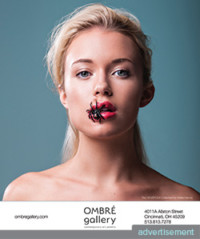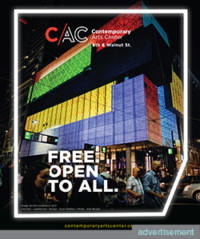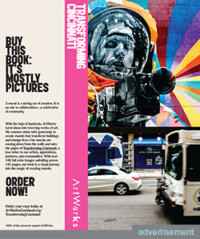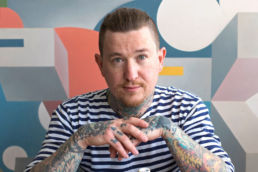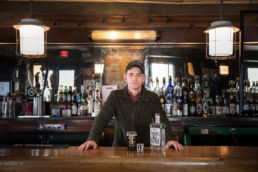 foreword DAVID COPPERFIELD | photography JERRY METELLUS | photography assistant KEVIN DYER
foreword DAVID COPPERFIELD | photography JERRY METELLUS | photography assistant KEVIN DYER
drawings HOMER LIWAG | hair and makeup SHAUN SAUNDERS | stylist CHRISTIE MOELLER
Homer Liwag is a man of magic. Not in the way you think I mean (even though he’s a very talented magician in his own right), he’s also a magician in the purest sense of the word—a modern-day Renaissance man with an infinite array of skill sets, some yet to be discovered.
During the past twenty years of collaboration, I’ve witnessed him become a superb video and music editor, an innovative master of complicated stagecraft, an accomplished photographer, cinematographer, illusion inventor and designer, and much, much more.
All of this, coupled with his background in industrial design, is changing how the world views the art of magic. Everything he touches, he tries to outdo himself and what has existed before.
I’m always excited to provide ideas and opportunities just to see what Homer will do with them. Our amazing executive producer, Chris Kenner, and I call it “Homerizing”: Homer’s ability to take anything and make it a little better, or in most cases, a lot better.
I look forward to the new creations, the innovations, the wonders that are coming next.
– David Copperfield
Polly: How old were you when you discovered your interest in magic?
Homer: I was around eight or so when a friend of the family showed me a simple card trick. Since he wouldn’t show me how it was done, I became very curious. A couple of days later I was walking around a store and I saw a magic book that came with a trick deck. That was the start of the magic side of me. I’ve always had the artistic side of me as a result of being around my dad, who is an incredible artist of many mediums.
P: How does a guy who was born in Montreal and grew up in Cincinnati find himself living in Las Vegas and working for David Copperfield? Did you have a lucky break, or was it a result of knocking on a lot of doors?
H: When I was young, my parents had a small food counter at the renovated Union Station in Cincinnati, Ohio, where I would help out during weekends and summer vacations. I spent many hours being bored when business was slow. Luckily, there was a FAO Schwarz about two hundred feet away inside the Station. That is where I met Jeff Connor—a close-up magician, standup
comedian, and all-around great guy. He let me borrow books and became my mentor. I would take a book home, practice a few card tricks, and come back and show him. He would critique me and give me advice—sometimes being brutally honest. You may know him as the ring announcer from Mark Burnett’s hit show, The Contender. The second gentleman that got me going down a good path toward magic was a teacher at my grade school, Mr. Williams.
When I got older and was applying to the University of Cincinnati, I knew I wanted to do something related to art. My dad is an amazing fine artist, and I seemed to have a knack for drawing because of him. My grades weren’t good enough to enter UC’s prestigious graphic design program (ranked number two at the time behind Art Center in Pasadena), so I entered into their industrial design program (also rated number two). Little did I know that industrial design school would teach me the perfect skills I needed to excel at my current job designingfor David Copperfield! It wasn’t until I was preparing for my thesis that I boldly stated to my classmates, “I want to design an illusion that David Copperfield will perform on a national television special.” Silence. I never got my degree, but I did eventually get my wish, tenfold.
Around 1987, a magic-themed restaurant named Illusions opened in Carmel, Indiana. This opportunity was a major change in direction for my magic career. Soon after it opened, I placed second in a magic convention competition, where the winners got a chance to perform for a week at the new restaurant. At lllusions, I met Chris Kenner—one of my best friends, boss, and collaborator that, twenty-eight years later, I still work with daily. While I was studying industrial design at the University of Cincinnati, I would drive to Indiana every weekend to hang out with Chris and watch magicians do their thing. Chris and I started doing creative projects together, which included writing and illustrating magic books, publishing a magic newsletter, and creating original magic. Eventually, I was skipping more school and doing more magic. By 1992, I decided to move to Indiana full-time. Illusions became a new life, where I could work on new magic and perform for hundreds of people nightly. Being able to work on a new trick and immediately test it out on a room full of people—people that could easily boo me off stage—was an experience I’m very grateful for.
My transition to working with David Copperfield was due to Chris Kenner, who had become David’s friend, executive producer, and magic consultant. He was the one who opened the right door at
the right time. I’m not the “knock on the door” type of person, and I’m terrible in situations where I need to walk up to strangersand sell myself. The show was touring the world heavily at the time, and there was no room for extra personnel. When one of David’s administrative assistants quit one morning, Chris told David, “Well, Homer can type fast.” Within hours I was on a plane to Providence, Rhode Island, where the show was performing that night. I was never great at filing and typing letters. Fortunately, David realized that I could design and work on magic, so he started to cultivate those skills. That is how my two parallel backgrounds eventually coalesced.
P: What is your favorite kind of magic? How would you characterize your style?
H: There is nothing better than being fooled by a good magic trick. It’s even better when the performer brings something original to the effect, whether it’s a twist on presentation or a great sense of humor. I grew up watching David Copperfield on television, so I am extremely biased. Honestly, no one can command the stage or present an illusion and leave the audience with an emotion better than David. Many magicians will hate me for saying this, but no one really comes close. Even early in David’s career he could take an off-the-shelf illusion and wrap it in a story, set it to unique music, and leave the audience with a feeling that no other magician performing the same illusion could do.
When it comes to watching other magicians, I love close-up and comedy styles—where magic seems to just happen to solve a small “problem” or where everything you touch seems to be affected. I love David Williamson, Gaetan Bloom, and Tommy Wonder. I rarely work on my own magic these days, but I can watch the new crop of talented young magicians for hours.
P: Who was your hero/mentor growing up? Who is it now?
H: Other than watching David Copperfield on TV, when I was growing up my greatest passion was the design and art from Star Wars. I used to spend hours in that same bookstore paging through the Star Wars sketchbooks featuring the art of Joe Johnston. Even today, I use his architectural design sketching style as a benchmark for my own drawings. He’s the director for such films as The Rocketeer, Jurassic Park III, and Captain America. Of course, I admired the great concept painter Ralph McQuarrie, but Joe Johnston’s sketching style was something I knew I could learn.
Today, I consider David Copperfield and Larry Fong my mentors. A few years ago, I met and became great friends with cinematographer Larry Fong (300, Super 8, Batman v Superman). We’ve spent a great deal of time together and have exchanged hundreds of emails regarding cinematography. One day I want to put those emails into a binder. There’s a goldmine of wisdom that any learning cinematographer would kill for—especially if you know how to read between the lines.
I’ve been extremely fortunate that David Copperfield has exposed me to amazing artists and leaders in many fields, from movie directors to Disney CEOs. They’re opportunities I never take for granted. David has a way of inspiring me to outdo myself and push further. Because of David’s inspiration, I have learned and grown in so many disciplines that no school could ever teach.
P: Everything that I have seen written about you confirms one thing—you are a busy man! In addition to codirecting the show and creating and designing illusions for David Copperfield for more than twenty years, you are a published author, illustrator, filmmaker, and music producer. One must ask—do you have a personal life?
H: We’ve been so busy creating and developing illusions for our new show that I almost completely stopped doing personal projects in the past couple of years. A few years ago I switched to a “day shift,” which allows me to concentrate work into a solid block instead of spreading it out into the middle of the night during the shows with all of their inherent distractions. Now, when I get home I just want to do nothing. However, I recently started learning how to cook my favorite restaurant dishes. I can make a great scarpetta spaghetti and batali bolognese from scratch. My day shift also allows me to hang out with my wife, Aimée, after a long day at work. I am very lucky, because in my first fifteen years with David, we were constantly touring the world and pretty much lived and breathed our work eighteen hours a day.

P: Your peers credit you with being able to instinctively look at a trick or technique and know immediately how it works and how it can work better. How did you acquire this unique gift of being mechanically inclined?
H: When someone shows me a magic effect, I don’t always know how it works and, for that matter, I don’t care. I like being fooled and want to enjoy the experience. Who wants to go to Disneyland and point out that Mickey is just a person in a costume or that Star Tours is just a car on hydraulics? I want to suspend disbelief and enjoy the ride. I was never mechanically inclined, but I do have good instincts. My problemsolving process tends to be non-methodical. I draw from every possible source of inspiration to solve something instead of being bogged down by process and numbers. I probably get my sensibilities from my dad, who can draw, paint, sculpt, and build anything with any available materials. I also definitely pull from the amazing experience I had from six years of industrial design school, which is a trade of many disciplines.
P: David Copperfield has been heard using the phrase “Homerized” on the set, which in essence turns your name into an action verb. Tell us exactly what that means. How does it feel being turned into a verb?
H: The term “Homerized” has been mentioned in print a few times which means I’m starting to feel pressured to live up to it! In general, the term means I have the tendency to want to add a slight improvement to everything that I see. This applies to everything I do, even things outside of work. I think it’s a byproduct of growing up surrounded by very talented and opinionated people. I take a close look at things around me and think, “How can I make this better?” Now, almost on a daily basis, David will walk up to me during a rehearsal and say, “Homerize THIS!” Now that’s pressure!
P: You have been working with David in various capacities for more than twenty years. Being from the generation who was told to not expect longevity in employment, what do you think it is about this collaboration that has made it the exception to the rule?
H: The world is changing. We are now being influenced by kids that dropped out of school and created Facebook. My mom, and most Filipino parents it seems, has the mindset that you have to go to school and be a doctor or you are not successful. I was at a family party many years ago, and some people asked me what I did. When I said I was a designer for David Copperfield, they said, “But when will you get a real job?” I left that party.
P: David refers to you as a true “Renaissance Man.” You are a man who can do everything well—from design, photography, video and music editing, to lighting, choreography, and writing. How to you find time to “do it all”?
 H: When I produced my first magic instructional DVD in 2006, I did it mainly as an exercise in learning video production. Little did I know that I would start a small trend of non-talking, motion-graphic-based style of magic teaching.
H: When I produced my first magic instructional DVD in 2006, I did it mainly as an exercise in learning video production. Little did I know that I would start a small trend of non-talking, motion-graphic-based style of magic teaching.
With the popularity of Instagram, I use the social media platform for short, intermediate exercises of photography and filmmaking. Creating fifteen-second short movies on my iPhone keeps my head in filmmaking even if I can’t work on larger projects.
Luckily, I have very talented friends that I can draw from. My friend James Grote is a very talented iOS app designer and musician who I’ve known since high school. Every time I need music created from scratch, I call James. Every time I have a problem with my music editing software, I call James.
Lately, I’ve been itching to get my reel and portfolio up to date. When I discovered that one of my co-workers could sing extremely well, I decided to learn music production and produced a jazz, blue-eyed-soul-style cover of “Tom Sawyer” by Rush. I called James for the music. The singing and music were amazing. I’m currently in pre-production for shooting the music video.
P: You mentioned wanting to do more video and further explore cinematography. Do you see yourself directing movies?
H: I see myself directing “something.” I’ve worked briefly on sets helping out, and each time, I felt the yearning to be part of the creative decision process. I’ve stood on a set delivering a sandbag, and all I could think of was, “But the last take was better because the actress delivered her line with better emotion.” Of course, on any production, very talented and hardworking people are essential — electricians, grips, carpenters — but I think my calling is being involved with anything that directly affects the final product creatively. Even if I become a cinematographer, I think I would want to be heavily involved not just with the image making but with the story and design elements as well. I have heard that this is a very difficult thing to do. We’ll see!
With David’s new movie production company, Red Safe, I have been fortunate to have worked directly with feature films and Emmy-award-winning television shows. I was able to help choreograph and design the featured hangman illusion in Burt Wonderstone with Steve Carell and Steve Buscemi. We developed ideas for the successful Now You See Me film. We designed magic for the late, great Robin Williams on The Crazy Ones television show. The Amazing Race’s “Season 24 All-Stars” finale was quite a challenge with a tight deadline for creating an illusion from scratch involving contestants escaping from a small box set on fire and hanging from a crane in freezing temperatures.
I remember when I was very young, maybe seven or eight, I learned the word “cinematography.” I had trouble pronouncing it correctly. I called it “cinema-photo-graphy.” I told myself, “One day I want to be a cinema-photo-grapher . . . when I learn how to pronounce it correctly.”
View more behind-the-scenes photos from Homer Liwag here or click here to view his interview conducted by David Copperfield .





